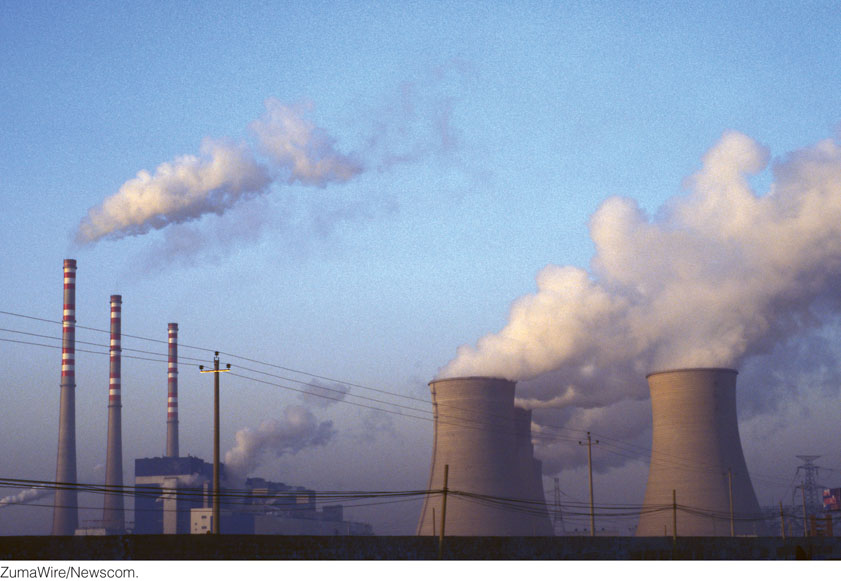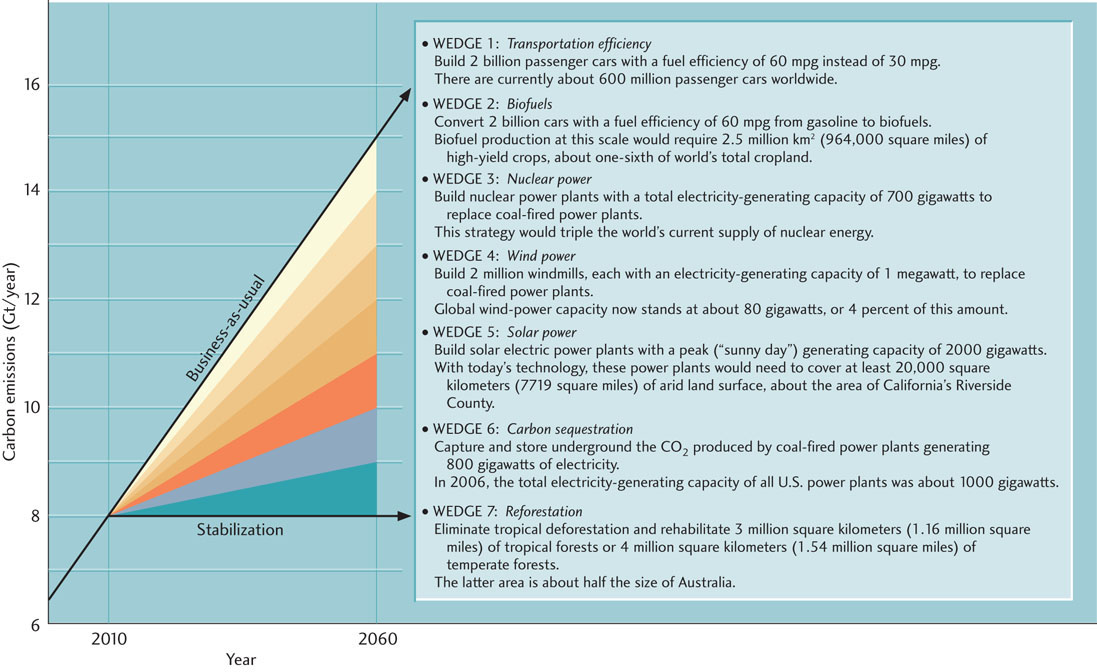Earth System Engineering and Management
By any measure, the problems we face in confronting global change are daunting. If the human population and its per capita energy use continue to grow at their current rates, our continuing reliance on fossil fuels will cause the rate of carbon emissions to nearly double in 50 years, from 8 Gt per year in 2010 to at least 15 Gt per year in 2060. Under IPCC’s extreme scenario A, the CO2 concentration in the atmosphere could exceed 600 ppm and continue to increase thereafter, with the potentially disastrous consequences we have described. Controlling our carbon emissions—perhaps civilization’s most important task—will require an extraordinary collaboration of Earth scientists, policy makers, and the public.
668
Energy Policy
There is little question that we will need to make changes in the energy sources we use and the ways in which we use them. One set of questions policy makers must tackle is how much money we should spend to curb anthropogenic carbon emissions, and whether the benefits of doing so will justify the costs. Too much spending could depress the economy and cause job losses, yet preventing the most drastic effects of climate change might be less costly than coping with those disasters after they happen.
A partial solution—and certainly the most economical one—is to improve energy use efficiency and reduce waste. In a real sense, using energy more efficiently is like discovering a new source of fuel. Some experts believe that the United States could reduce its emissions of greenhouse gases by as much as 50 percent from current levels by implementing efficiency measures that cost relatively little—for example, insulating buildings, replacing incandescent light bulbs with fluorescent bulbs, increasing the fuel efficiency of motor vehicles, and making greater use of natural gas. The savings in energy costs could amount to hundreds of billions of dollars per year. These modest steps would offer other fringe benefits as well, including lowered manufacturing costs and improved air quality.
Many observers would say that fossil fuels are simply too cheap in the United States. Carbon emissions are not taxed at a national level, as they are in many other developed nations; consequently, there is little incentive for energy conservation or conversion to new energy sources. The full economic costs of fossil fuels include the costs of cleaning up atmospheric pollution, oil spills, and other environmental damage; the costs of trade deficits; and the military costs of defending oil supplies, as well as the costs of global warming. If these costs were included in energy pricing, alternative energy sources would become much more competitive with fossil fuels. Such full-cost accounting has not been politically popular in the United States, however.
We also face the issue of fairness in international politics. The United States, Canada, the European Union, and Japan—with less than one-quarter of the world’s population—are responsible for about three-quarters of the global increase in atmospheric greenhouse gas concentrations. These rich industrial nations are better able to pay the costs of reducing their greenhouse gas emissions than the developing countries. China, for example, depends on its huge coal deposits for its rapid economic growth; it became the world’s leader in greenhouse gas emissions in 2007 (Figure 23.35). Developing nations argue that they will need financial and technological support from the developed countries to help them reduce emissions. Policy makers have come to agree that the problems of global climate change cannot be solved on a national scale and will have to be addressed through international cooperation.

669
Use of Alternative Energy Resources
As we have seen, no one alternative energy source will be able to replace fossil fuels quickly. However, some renewable energy resources, such as solar power, wind power, and biofuels, are becoming more important contributors to our energy system. If these technologies were aggressively implemented during the next 50 years, together they could reduce carbon emissions by gigatons per year.
Another step that could be taken is to increase the use of nuclear energy. The capacity of nuclear power plants, which today is approximately 350 gigawatts, could easily be tripled in the next 50 years, but this option is unattractive to many people for the reasons we have discussed. The potential exists for cleaner nuclear technologies, such as fusion power: the use of small, controlled thermonuclear explosions to generate energy. But scientific progress toward this goal has been slow, and conceptual breakthroughs will be required.
Engineering the Carbon Cycle
What about the possibility of engineering the carbon cycle to reduce the accumulation of greenhouse gases in the atmosphere? Several promising technologies aim to reduce greenhouse gas emissions by pumping the CO2 generated by fossil-fuel combustion into reservoirs other than the atmosphere—a procedure known as carbon sequestration.
One obvious alternative reservoir for carbon is the biosphere. In Chapter 15, we saw that forests withdraw CO2 from the atmosphere in surprisingly large amounts. Land-use policies that would not only slow the current high rates of deforestation but also encourage reforestation and other biomass production might help to mitigate anthropogenic climate change.
Biotechnology might provide some ways of increasing the capacity of the biosphere to sequester carbon. One possibility is the engineering of genetically modified bacteria that would be capable of metabolizing methane, sequestering the carbon it contains, and giving off hydrogen. Hydrogen is the ultimate clean fuel; burning it produces only water.
Another controversial possibility is fertilization of the marine biosphere. We know that phytoplankton (small photosynthetic marine organisms) take up CO2 from the atmosphere by photosynthesis. In most regions of the ocean, phytoplankton productivity is limited by the lack of nutrients, such as iron. Preliminary experiments in the 1990s suggested that the growth of phytoplankton could be stimulated by dumping modest amounts of iron into the ocean. Unfortunately, it appears that fertilizing the ocean in this manner also stimulates the growth of animals that eat the phytoplankton and quickly return the CO2 to the atmosphere.
One straightforward technology for carbon sequestration—underground storage of CO2—offers considerable promise. Carbon dioxide captured from oil and gas wells is already being pumped back into the ground as a means of moving oil toward the wells. If capture and underground storage of the CO2 from coal-fired power plants were economically feasible, the world’s abundant coal resources would become much more attractive as a replacement for petroleum.
Stabilizing Carbon Emissions
The strategies and technologies we have just discussed may seem promising, but will they be enough? Under the IPCC’s scenario A, carbon emissions are expected to increase by at least 7 Gt per year during the next half century. How can this increase be stopped? In other words, what would it take to stabilize carbon emissions at current levels?
Two scientists from Princeton University, Stephen Pacala and Robert Socolow, have provided a simple quantitative framework to address this particular problem. They begin by admitting that there is no single solution to the problem—no “silver bullet.” Instead, they break the problem into what they call stabilization wedges, each of which offsets the projected growth of carbon emissions by 1 Gt per year in the next 50 years (Figure 23.36). Therefore, one wedge roughly corresponds to one-seventh of the solution.

Implementing each stabilization wedge will be a monumental task. To achieve wedge 1, for example, the average gasoline mileage of the world’s entire fleet of passenger vehicles, which will grow to 2 billion by mid-century, will have to be steadily increased from 30 miles per gallon (mpg) to 60 mpg. This calculation assumes that a car is driven 10,000 miles per year, the current annual average. An alternative, not shown in the figure, would be to maintain gas mileage at 30 mpg but reduce the average amount of driving by half to 5000 miles per year. Yet another alternative (wedge 2) would be to convert all cars to biofuels. Growing that much biofuel would take up one-sixth of the world’s total cropland, so this strategy could adversely affect agricultural productivity and food supplies.
Some of the stabilization wedges involve controversial or expensive technologies, such as expanding nuclear power by a factor of three (wedge 3), increasing the number of large windmills into the millions (wedge 4), or covering large desert areas with solar panels (wedge 5). At least one of the proposed wedges, the capture and storage of carbon emitted from coal-fired power plants (wedge 6), is at the margin of current technological feasibility. The last option, elimination of tropical deforestation and the reforestation of huge additional land areas (wedge 7), is favored by many people in principle, but would be difficult to achieve without imposing severe restrictions on developing countries such as Brazil.
670
The stabilization of carbon emissions at current emission rates would reduce, but not eliminate, the threat of global climate change. The 50-year stabilization scenario (which is intermediate to scenarios B and C in Figure 23.36) would still allow the atmospheric concentration of CO2 to grow to 500 ppm, almost twice the preindustrial value. Further reductions in carbon emissions during the second half of the twenty-first century would be necessary to maintain atmospheric concentrations below that value. Climate models indicate that such a scenario would still increase the average global temperature by about 2°C, more than three times the total twentieth-century warming.
Nevertheless, the continued rise of atmospheric CO2 concentrations is not inevitable. The available inventory of stabilization wedges constitutes a technological framework for concerted action by governments. Taking on the stabilization problem involves other difficulties such as developing broad public consensus and creating international agreements. Yet, as the Pacala-Socolow analysis demonstrates, there is still time for actions that can substantially reduce anthropogenic global change. Whether we can grasp this opportunity will depend on our understanding of the problem, its potential solutions, and the consequences of inaction.
Sustainable Development
The term sustainable development appears with increasing frequency in newspapers, public debates, classroom discussions, and scholarly journals. The concept was popularized in Our Common Future, a 1987 report by the World Commission on Environment and Development (also known as the Brundtland Commission), where it was defined as “development that meets the needs of the present without compromising the ability of future generations to meet their own needs.” Sustainable development is difficult to define more precisely, but it offers an appealing, if somewhat utopian, vision: a civilization that carefully manages its interactions with the Earth system to ensure a hospitable environment for future generations.
Sustainability involves many economic and political issues about which many nations do not agree, so forging a global strategy that moves civilization toward this goal will not be easy. As a prerequisite, Earth science will have to provide better knowledge of how geosystems operate, interact, and are perturbed by human activities.
671
As French novelist Marcel Proust once wrote, “The real voyage of discovery consists not in seeking new lands, but in seeing with new eyes.” We hope this textbook has given you new eyes to see the critical issue of global change and the other problems of Earth science that confront your generation.